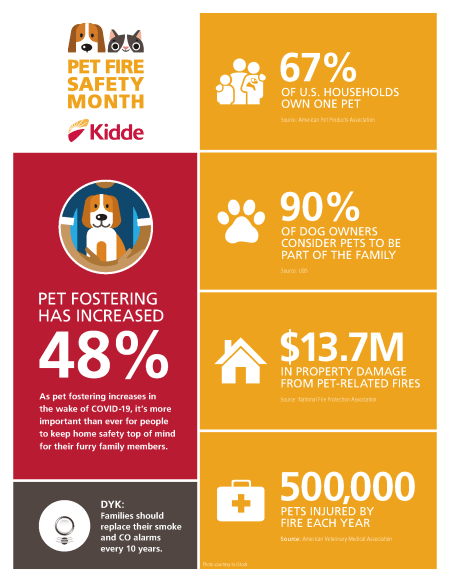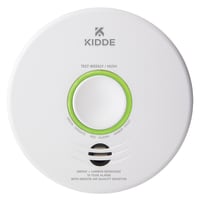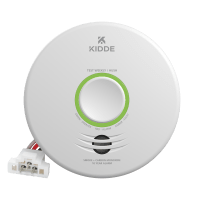Pets Can Start Fires
According to the National Fire Protection Association, nearly 1,000 home fires each year are started by family pets. Practicing simple safety tips can make a big impact in protecting your family and pets.
Household Tips
-
Pet proofing: Like with human children, homes most often require pet proofing. Pay careful attention to objects such as stove knobs and hot appliances that can be knocked over or turned on by curious pets. Never leave a lit candle within reach of a pet. Discard or store leftover food out of reach to prevent pets from trying to grab it (i.e. avoid leaving food on the stove).
-
Train pets to alarm sound: Dogs may become unsettled or anxious when a smoke alarm sounds, running and hiding rather than heading toward the door. Kidde recommends families work with skilled, professional trainers to help their canine friends learn how to properly respond to alarms.
-
Window clings: In an emergency, first responders need to be able to quickly assess the number of pets in a home. Consider attaching a removable/replaceable decal to a window near entrances to let rescuers know how many animals are inside.
-
Include pets in escape plans: Pets should always be included in a family's evacuation plan. Stay aware of their typical hiding spots and where they often nap in case you must evacuate quickly, and assign a family member to account for each pet. Keep an emergency kit with food, medication, and a leash near the exit. When you're not home, keep pets in areas near entrances where emergency responders can easily find them.
-
When you leave home: Pets can be mischievous, so consider confining them to a specific area, ideally close to an entrance - using items like a crate or dog gates - to keep them safe and to make it easier for first responders to remove them quickly to safety in case of emergency.
-
Replace alarms at 10 years: Smoke alarms must be replaced after 10 years. In addition to testing alarms once each week, check the manufactured date on your smoke and carbon monoxide alarms to make sure they're current. If they're older than 10 years of age, it's time to replace them.

Plan ahead
Save contact information for your veterinarian in a place where you and other family members can easily access it, such as your phone contacts or a cloud-based shared file. Research local boarding options, hotels that allow pets, and friends or family members who might take in your pet temporarily. Also, be sure your pet's microchip information is current in case you become separated in an emergency.
Pets & Carbon Monoxide
Like all members of the family, pets are just as susceptible to the dangers of CO. But, some pet parents may not know how to spot the symptoms. According to a recent survey, 61 percent of pet owners in Canada aren't confident they could identify the symptoms of CO poisoning in their pets. As part of Carrier's Healthy Homes Initiative, Kidde is sharing important advice to help people protect their furry family members.
Sources of Carbon Monoxide
Carbon monoxide is a colorless, odorless, and tasteless gas that is created by any fuel-burning appliance. When power outages occur during emergencies such as hurricanes or winter storms, the use of alternative sources of fuel or electricity for heating, cooling, or cooking can cause CO to build up in a home, garage, or camper and poison the people and animals inside. Common sources of CO in our homes include:
-
Heaters
-
Gas Stoves and Ovens
-
Generators
-
Grills
-
Fires/Chimneys
-
Cars

Know the Signs
The first signs of CO poisoning in pets are typically nausea and vomiting, followed by difficulty breathing. Most symptoms of CO poisoning or carbon monoxide toxicity in pets are nonspecific, meaning they could easily be attributed to other illnesses. It's important to keep working CO alarms throughout the home. Here's a short list of symptoms*:
-
Nausea
-
Vomiting
-
Labored or difficulty breathing
-
Sleepiness or lethargy
-
Uncoordinated movement
-
Disturbances in gait
-
Seizures
-
Heart arrhythmia
-
Coughing
-
Deafness
-
Blindness
-
Coma
Detecting CO in Your Home
The best and simplest way to detect the presence of carbon monoxide in your home is with a CO alarm. The way CO travels is different than smoke, it can travel anywhere in the home - even through drywall! With most homes, 1 alarm is not ideal protection. Consider installing more than 1 alarm on each level of your home. Pay careful attention to rooms where you and your family spend a great deal of time including living areas, bedrooms and hallways.
IMPORTANT: EVERY ALARM MUST BE REPLACED AT A MINIMUM OF 10 YEARS. In addition to testing alarms once each week and replacing batteries (where applicable), check the installation date too. If you have forgotten when they were installed, there's a simple fix: look on the back of the alarm for the manufacturing date and add 10 years.
Plan ahead
Save contact information for your veterinarian in a place where you and other family members can easily access it, such as your phone contacts or a cloud-based shared file. Also, be sure your pet's microchip information is current in case you become separated in an emergency.
*Source: Fitzgerald, K.D. (2006). Carbon Monoxide. In M.D. Peterson, Small Animal Toxicology (Second Edition) (pp. 619-628).
doi:https://doi.org/10.1016/B0-72-160639-3/50038-1



